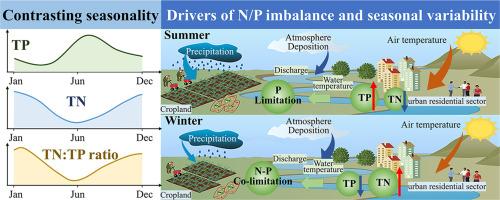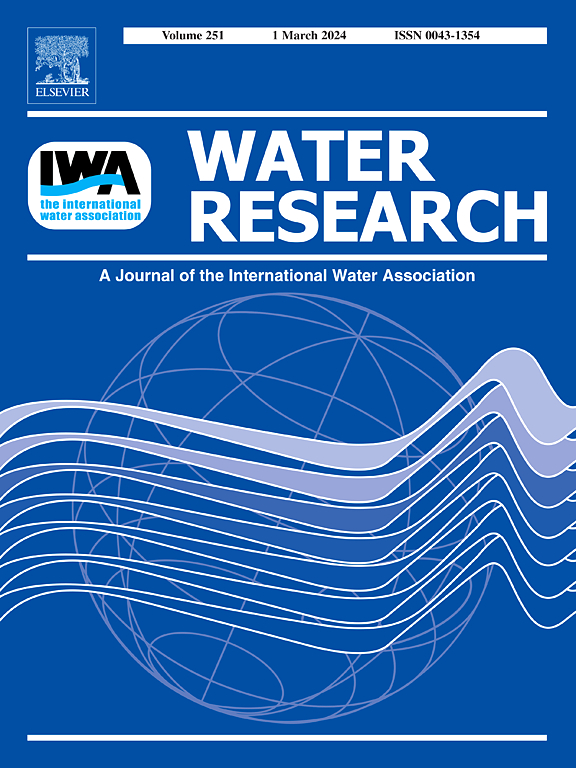Contrasting seasonal variations in riverine nitrogen and phosphorus concentrations in China: implications for N/P imbalances
IF 12.4
1区 环境科学与生态学
Q1 ENGINEERING, ENVIRONMENTAL
引用次数: 0
Abstract
Rivers are critical conduits of nitrogen (N) and phosphorus (P), essential nutrients that regulate the productivity and resilience of freshwater ecosystems through seasonal fluctuations. However, comprehensive assessments of the seasonal dynamics of N, P, and their stoichiometric ratios in river ecosystems, as along with the underlying natural and anthropogenic drivers of the magnitude of these seasonal variations, remain scarce. In this study, we conduct an investigation of seasonal variations in total nitrogen (TN), total phosphorus (TP) concentrations, and their stoichiometric ratios across 150 medium-sized river basins in China. Our findings reveal starkly contrasting seasonal trends: TP concentration peaks in spring and summer, while TN concentration reaches maximum levels in winter, resulting pronounced intra-annual fluctuations in TN:TP ratios. These divergent dynamics are modulated by a complex interplay of hydrological variability, temporal autocorrelation in nutrient concentrations, and temperature-driven processes. Seasonal fluctuation in the TN:TP ratio leads to spatiotemporal variability in nutrient constraints. Seasonal differences in water temperature and the magnitude of TN variability explain 22 % and 14 % of this variation, respectively, while climatic factors and anthropogenic influences account for 15 % and 13 %. Phosphorus-limitation dominates most river systems year-round, but seasonal shifts toward N-P co-limitation occur in southern basins during warmer months. Water temperature emerged as a primary driver, influencing the magnitude of seasonal variability in nutrient concentrations, with hydrological discharge and human activities providing additional influence. The seasonal variability of TN and TP is substantially greater in northern basins than in southern basins, and this regional heterogeneity is closely associated with differences in climate, land use, and anthropogenic inputs. These findings underscore the need for regionally adaptive, season-specific nutrient management strategies to address growing N/P imbalances exacerbated by climate change and anthropogenic impacts.


中国河流氮磷浓度的季节变化对比:对氮磷失衡的影响
河流是氮(N)和磷(P)的重要通道,而氮和磷是通过季节波动调节淡水生态系统生产力和恢复力的必需营养素。然而,对河流生态系统中氮、磷的季节动态及其化学计量比的综合评估,以及这些季节变化幅度的潜在自然和人为驱动因素,仍然很少。本研究对中国150个中等流域的总氮(TN)、总磷(TP)浓度及其化学计量比进行了季节变化研究。我们的研究结果揭示了截然不同的季节趋势:全氮浓度在春季和夏季达到峰值,而全氮浓度在冬季达到最高水平,导致全氮:全磷比率的年内波动明显。这些不同的动态受到水文变异性、养分浓度的时间自相关和温度驱动过程的复杂相互作用的调节。全氮:全磷比的季节波动导致养分约束的时空变异。水温的季节差异和全氮变率的幅度分别解释了22%和14%的变化,而气候因子和人为影响分别解释了15%和13%。磷限制在大多数河流系统中占主导地位,但在温暖的月份,南部盆地向氮磷共同限制的季节性转变发生。水温是影响养分浓度季节性变化幅度的主要驱动因素,水文排放和人类活动也提供了额外的影响。全氮和全磷的季节变异在北部盆地明显大于南部盆地,这种区域异质性与气候、土地利用和人为投入的差异密切相关。这些发现强调,需要采取区域适应性的、特定季节的养分管理策略,以解决因气候变化和人为影响而加剧的日益严重的N/P失衡。
本文章由计算机程序翻译,如有差异,请以英文原文为准。
求助全文
约1分钟内获得全文
求助全文
来源期刊

Water Research
环境科学-工程:环境
CiteScore
20.80
自引率
9.40%
发文量
1307
审稿时长
38 days
期刊介绍:
Water Research, along with its open access companion journal Water Research X, serves as a platform for publishing original research papers covering various aspects of the science and technology related to the anthropogenic water cycle, water quality, and its management worldwide. The audience targeted by the journal comprises biologists, chemical engineers, chemists, civil engineers, environmental engineers, limnologists, and microbiologists. The scope of the journal include:
•Treatment processes for water and wastewaters (municipal, agricultural, industrial, and on-site treatment), including resource recovery and residuals management;
•Urban hydrology including sewer systems, stormwater management, and green infrastructure;
•Drinking water treatment and distribution;
•Potable and non-potable water reuse;
•Sanitation, public health, and risk assessment;
•Anaerobic digestion, solid and hazardous waste management, including source characterization and the effects and control of leachates and gaseous emissions;
•Contaminants (chemical, microbial, anthropogenic particles such as nanoparticles or microplastics) and related water quality sensing, monitoring, fate, and assessment;
•Anthropogenic impacts on inland, tidal, coastal and urban waters, focusing on surface and ground waters, and point and non-point sources of pollution;
•Environmental restoration, linked to surface water, groundwater and groundwater remediation;
•Analysis of the interfaces between sediments and water, and between water and atmosphere, focusing specifically on anthropogenic impacts;
•Mathematical modelling, systems analysis, machine learning, and beneficial use of big data related to the anthropogenic water cycle;
•Socio-economic, policy, and regulations studies.
 求助内容:
求助内容: 应助结果提醒方式:
应助结果提醒方式:


